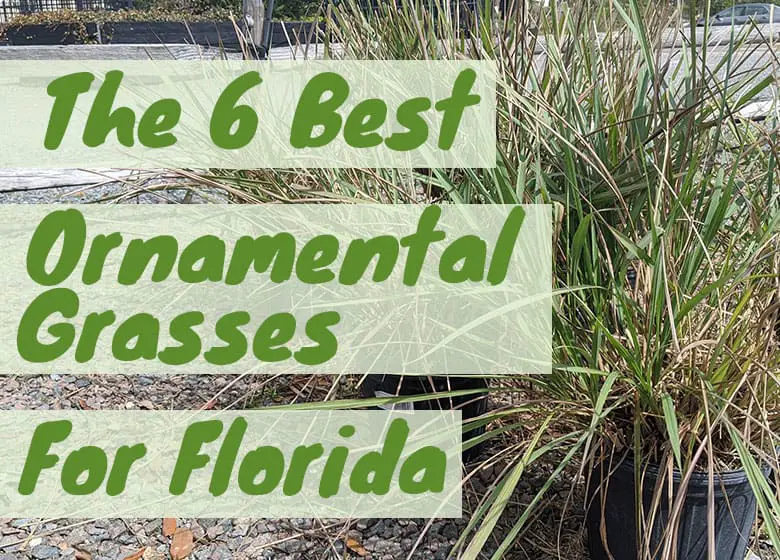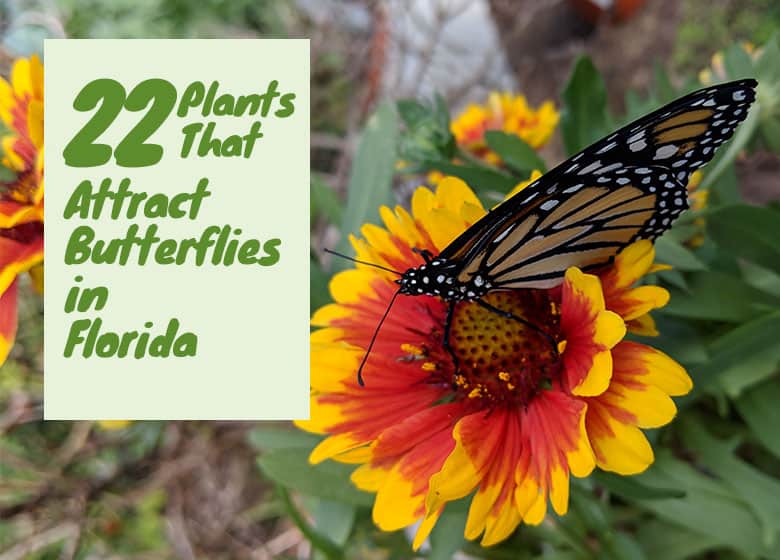
What plants attract butterflies in Florida?
Bottlebrush, Firebush, Milkweed, and Lantana are some of the more common plants that attract butterflies to a Florida garden. If you want to have a successful butterfly garden in Florida you must also think about having both nectar and host plants, but also provide a water source and shelter for butterflies and baby caterpillars.
Boasting more than 180 different butterflies, with many native to the state and holding the honor of having the most diverse butterfly species east of the Mississippi River, Florida is a butterfly paradise for those wishing to grow plants to attract the fluttering beauties to their garden. Butterfly gardens not only attract these beneficial pollinators but also add year-round color to the landscape and help the local ecosystem remain healthy.
The state’s subtropical climate makes it possible to grow a wealth of different plants that promise to attract butterflies to your landscape. Whether you are looking for a specific flower color, plant size or ones tolerating specific conditions, there are butterfly plants suiting your taste and butterfly garden design.
Continue reading because we cover basic butterfly gardening tips and details on common butterfly-attracting plants that will have your Florida garden ablaze in color and flamboyant fluttering wings.
Plants That Attract Butterflies In Florida
Black-eyed Susan
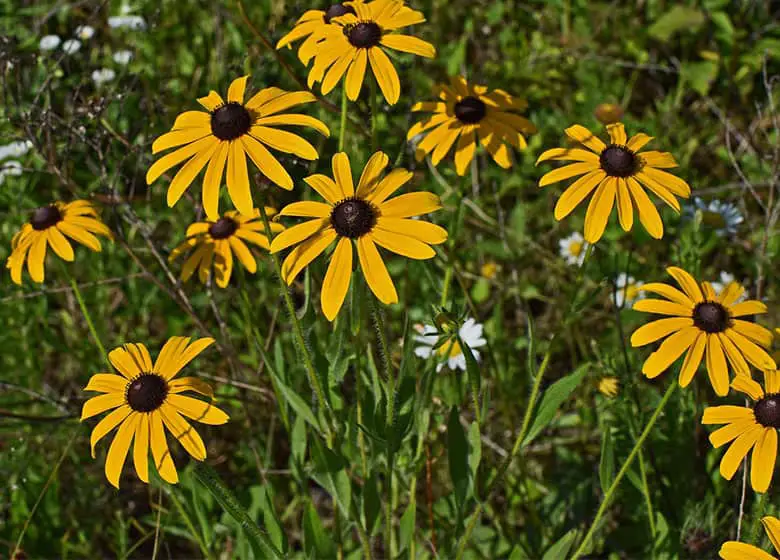
Forming 2- to 3-foot mounds, black-eyed Susan bursts onto the scene in summer and fall with a vibrant display of yellow or orange daisy-like flowers with large brown centers. Deadheading spent blooms promotes more flowers. The perennial grows well in all areas of the state, thriving in full sun and a variety of well-drained soils. It’s a good choice for seaside gardens as the plant is salt- and drought-tolerant.
Bottlebrush
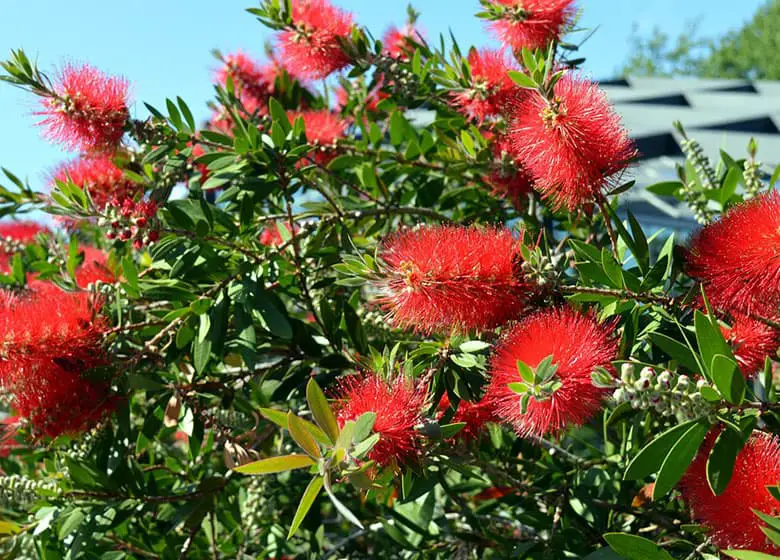
Bottlebrush is a must have for those wanting a larger shrub that attracts butterflies as well as hummingbirds in Central and South Florida. The evergreen produces intense red flower spikes, blooming spring through fall adding color to the landscape almost year-round. Gardeners have choices in an upright and weeping variety that produce the same colorful blooms and the upright form grows up to 20 feet tall and wide. Bottlebrush grows best in full sun and in a variety of well-drained soils and is salt- and drought-tolerant.
Butterfly Bush
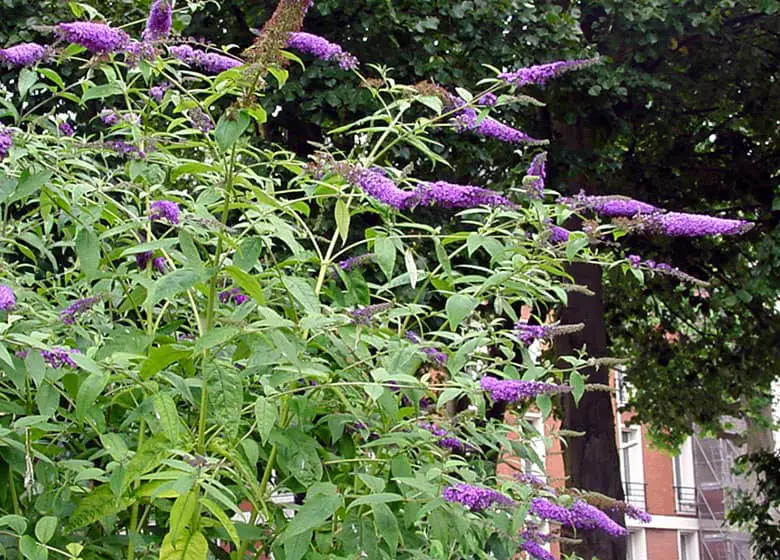
Butterfly bush does just what its name suggests – attracts a wealth of butterflies as well as bees to the garden. The semi-evergreen perennial fills with fragrant flower clusters that can be 2 feet long and depending on the cultivar, can be purple, white or pink. Although it grows well statewide, Florida offers many drawbacks to planting it directly into the ground, as nematodes, rust and mites cause problems. For the best looks and least amount of problems, grow butterfly bush in containers and situate in full sun. It has a low tolerance to salt spray and drought.
Coral Bean

Native coral bean plants offer color and interest to a butterfly garden spring through fall, and the perennial thrives in gardens statewide. In springtime, tall spikes fill with red tubular flowers that attract butterflies and hummingbirds. Spent flowers develop into seedpods that split open in fall revealing bright red seeds held inside. The seeds are poisonous. Plants grow anywhere from 5 to 15 feet tall with a similar spread and warmer conditions produce larger plants. It grows well in sun to partial shade and in a variety of well-drained soils. Coral bean is drought- and salt-tolerant.
Coral Honeysuckle
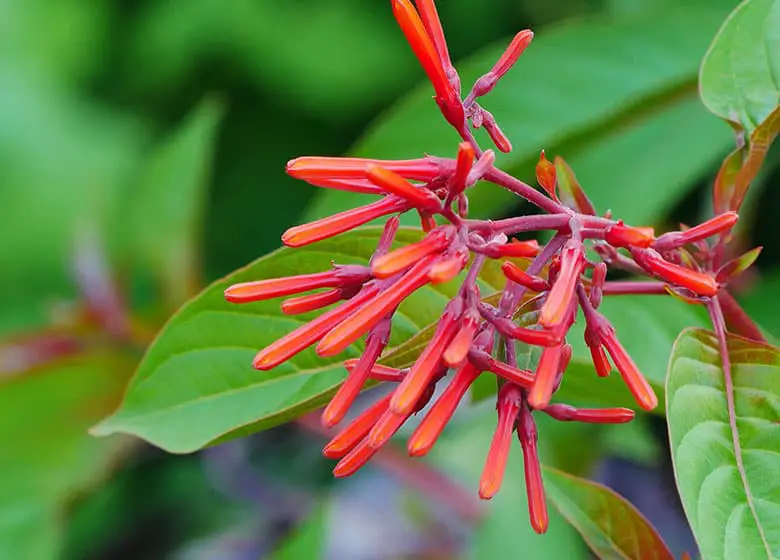
Coral honeysuckle is a native vine that grows well in all areas of Florida. In springtime, long tubular flowers form in clusters and continue blooming through summer, attracting hummingbirds as well as butterflies. Depending on the variety, flowers are coral red or yellow. The spent flowers form into berries, which attracts a variety of songbirds to the area. The foliage also adds colorful interest, as the top of the leaves are glossy green, with silvery green undersides. Coral honeysuckle tolerates sun to partial shade, but produces the most blooms situated in full sun and tolerates a variety of slightly acidic well-drained soils. It performs as an evergreen in Central and South Florida and semi-evergreen in North Florida.
Dill

Although an aromatic herb with multiple culinary uses, dill also makes a fragrant and useful addition to butterfly gardens throughout the state. According to the University of Florida, the cultivar ‘Long Island Mammoth’ is best suited for growing in Florida. Dill is an important component to butterfly gardens as it works as a host plant and is the chosen host for the black swallowtail. Dill performs well in a sunny site with fertile well-drained soil. If you are low on space or want to add color to a patio, dill also performs well in containers.
Fennel
Fennel makes a good addition to butterfly gardens statewide when temperatures cool in fall and winter. Although the licorice-tasting culinary herb is primarily grown for its shoots, foliage and seeds, caterpillars, like those of the black swallowtail use it as a host plant. The clusters of small yellow flowers form umbels and attract butterflies. Grow fennel in a sunny location with rich, well-drained soil and water regularly. Fennel also performs well grown in containers.
Firebush

Native firebush offers almost year-round color with its bright clusters of red tubular flowers blooming from spring until a frost followed by clusters of small dark berries. Hummingbirds delight in the flowers, as well as butterflies like the gulf fritillary and zebra longwing. The shrub also attracts birds feasting on the berries. The evergreen thrives statewide, but those in North Florida may have it die to the ground only to regrow in spring. Firebush produces the most flowers situated in full sun, although it also grows in partial shade and in well-drained soil. It’s a welcome addition to gardens along the coast as its salt-tolerant and tolerates drought once established.
Firecracker Plant
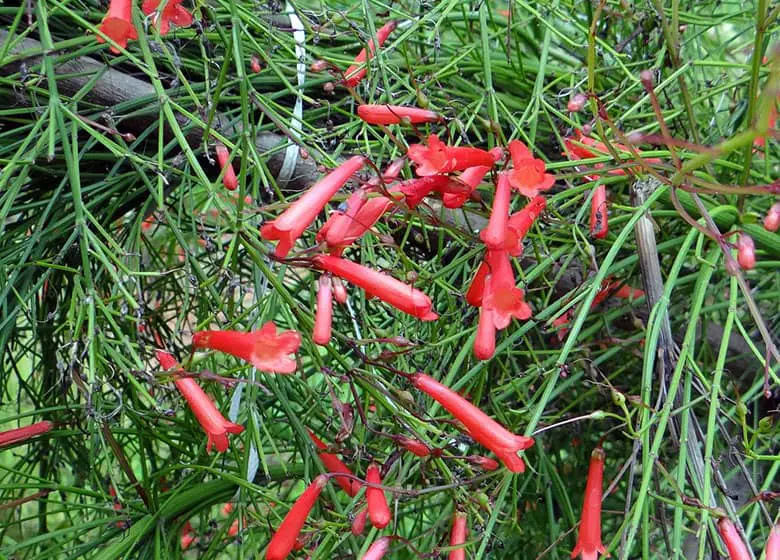
For an explosion of year-round color and a plant that hummingbirds and butterflies can’t stay away from, firecracker plant is sure to add eye-catching effects to a butterfly garden.
The finely textured and thin green leaves form into weeping mounds, with a profusion of bright red, yellow or salmon flowers seeming to rain over the sides. Gardeners in Central and South Florida can grow firecracker plant as a perennial and those in cooler northern sections can either treat it as an annual or grow it in containers for winter protection. It flowers best grown in full sun and in well-drained soil and plants are salt- and drought-tolerant.
Firespike
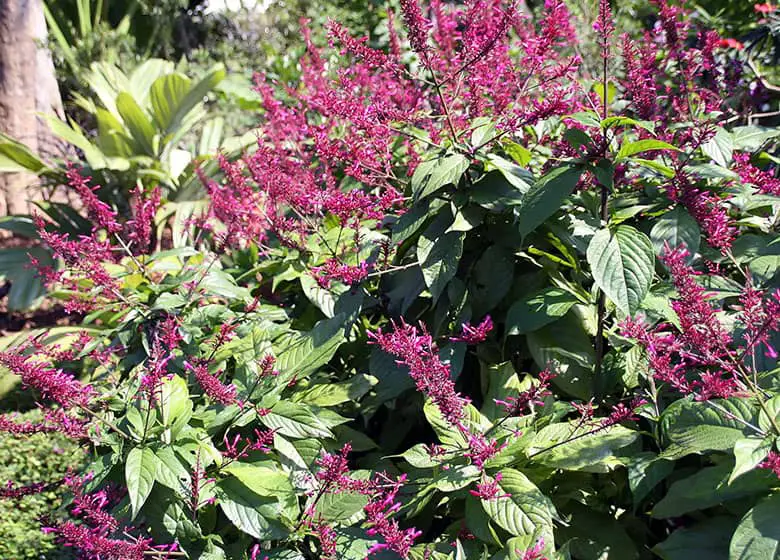
For a dramatic, year-round blooming evergreen shrub that’s an essential addition for butterfly and hummingbird gardens, you can’t go wrong with firespike. It makes a picturesque display with its 6-foot tall stiff and upright branches covered in large shiny green leaves with foot long panicles on top filled with brilliantly red tubular flowers. In areas of the state experiencing freezes, firespike dies to the ground only to resprout in spring. It grows in a variety of well-drained soils located in full sun to partial shade and is relatively drought- and salt-tolerant once established.
Gumbo-Limbo Tree
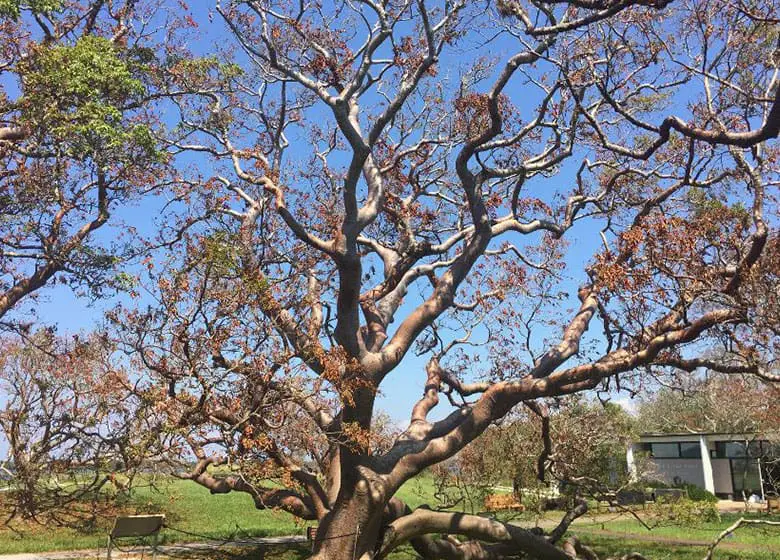
A South Florida native, gumbo-limbo trees will only thrive in the warmest areas of the state where frosts and freezes aren’t common. It adds an interesting appeal to landscapes with its smooth and coppery-colored peeling bark, leaving the trunk with a glossy appearance. Panicles of greenish-white flowers emerge in spring, which attract various butterflies. Gumbo-limbos form into large trees, growing anywhere from 25 to 50 feet tall, so they require a larger space in the landscape or butterfly garden. These are salt- and drought-tolerant semi-evergreen trees that tolerate growing in full sun to partial shade and in various well-drained soils.
Jatropha
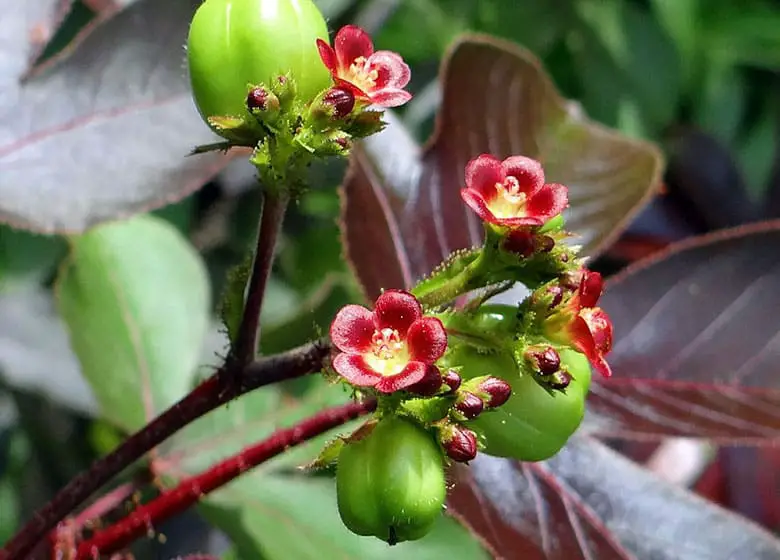
Jatropha plants offer a year-round brilliantly colored display of clusters of bright red or pink flowers that will have hummingbirds and butterflies visiting your garden. The two common species of this evergreen shrub or small tree that are hardy growing in South and Central Florida are Jatropha integerrima, commonly called peregrine and Jatropha multifidi, better known as coral plant. Although they flower best grown in full sun, they also tolerate growing in partial shade and in a variety of well-drained soils.
Lantana
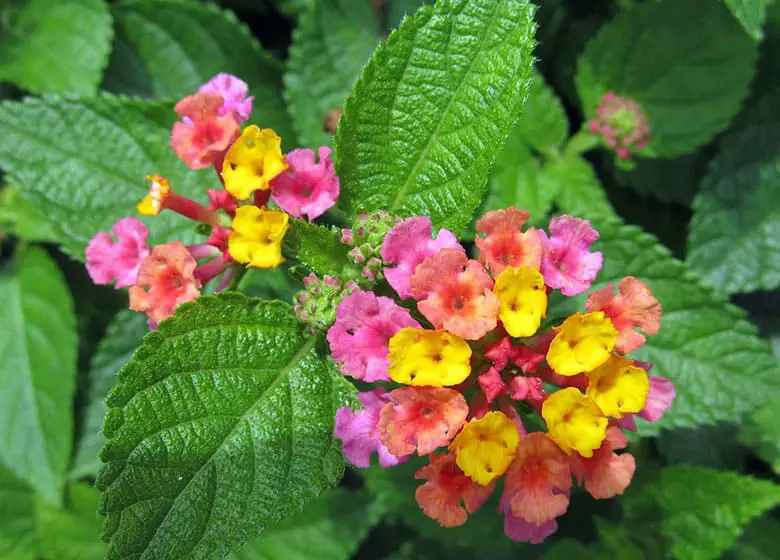
It’s easy to see why lantana is so popular in gardens throughout the state. Besides the fact that butterflies and bees love the almost year-round flower clusters, this evergreen perennial is drought-, heat- and salt-tolerant, as well as being an easy to grow and low-maintenance plant. Depending on the cultivar, the clusters of blooms range in colors of red, purple, yellow, white and orange, with some a mix of all the colors. Lantana performs well as a groundcover, small shrub or potted plant and is sure to brighten butterfly gardens with its profuse colorful display of blooms. It performs best located in a sunny site in well-drained soil and although tolerant of drought, regular water applications produce the most abundance of blooms.
Lion’s ear
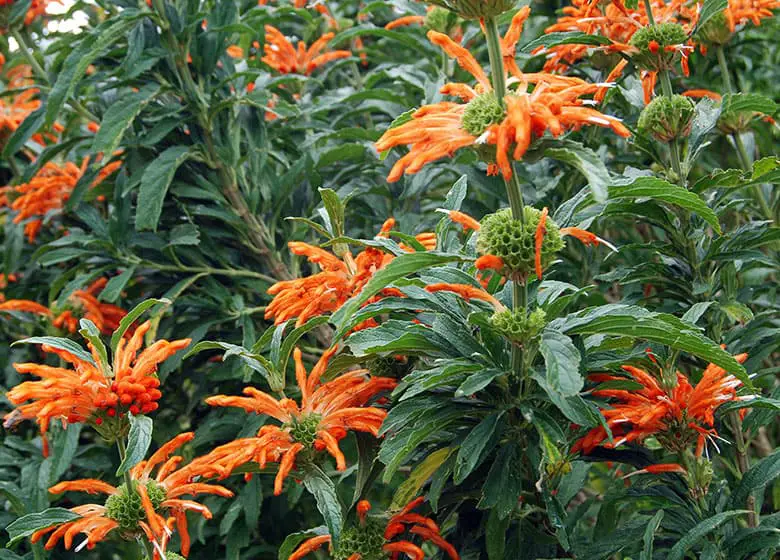
Lion’s ear gets its common name from the flower petals that resemble a lion’s ear. This tropical perennial shrub blooms in summer and keeps the color going through winter with its unique and eye-catching orange two-lipped tubular flowers that form into tiered whorls around the stems. It’s a great addition to butterfly gardens as it attracts bees, hummingbirds and butterflies. Plants can grow 3 to 6 feet tall and it’s hardy growing statewide, although those experiencing freezes may have it die to the ground and resprout in spring. This drought-tolerant plant prefers a site with well-drained soil located in full sun to partial shade.
Milkweed

Milkweed works overtime as a nectar source for various butterflies, bees and some insects, as well as a host plant and is the only plant monarch butterfly caterpillars eat. There are two varieties of milkweed commonly found in the state, the native butterfly weed (Asclepias tuberosa) and tropical milkweed (Asclepias curassavica), with both performing as perennials statewide. Butterfly weed blooms with clusters of orange or yellow flowers that start putting on their colorful show in summer throughout fall. Tropical milkweed blooms year-round producing clusters of tubular flowers in red, orange and yellow. These salt- and drought-tolerant perennials prefer as site located in full sun to partial shade and in well-drained soil.
Mexican Heather
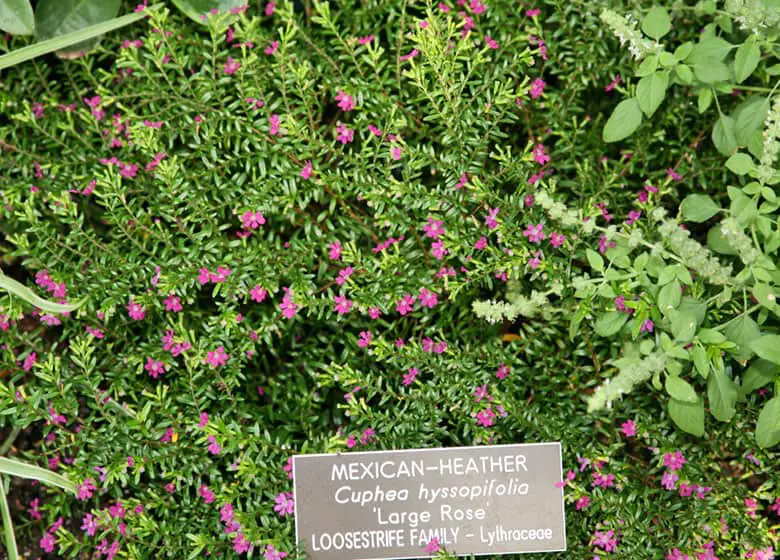
Mexican heather offers a year-round and non-stop show of tiny purple, white or red blooms against lacy dark green foliage, with the flowers attracting beneficial pollinators like bees, hummingbirds and butterflies. This evergreen perennial forms into dense and compact flowering shrubs averaging around 12 inches tall. It also performs well in containers. For the best performance, grow this hardy bloomer in full sun to partial shade and in rich, well-drained soil. Mexican heather performs as a perennial in frost-free sections of Florida and in cooler regions, gardeners should treat as an annual or grow it in pots for protection during winter.
Parsley

Gardeners throughout Florida should treat parsley as a cool-season annual, as the intense heat of summer is generally too hot for it to perform as a biennial. This culinary herb has a wealth of uses in the kitchen but it’s also a host plant to butterfly caterpillars like the black swallowtail. The yellow flowers spikes also attract butterflies. Grow parsley in the garden in a site with fertile, well-drained soil and in a location that gets morning sun and some shade during the afternoon. Parsley also performs quite well grown in containers.
Passion Flower
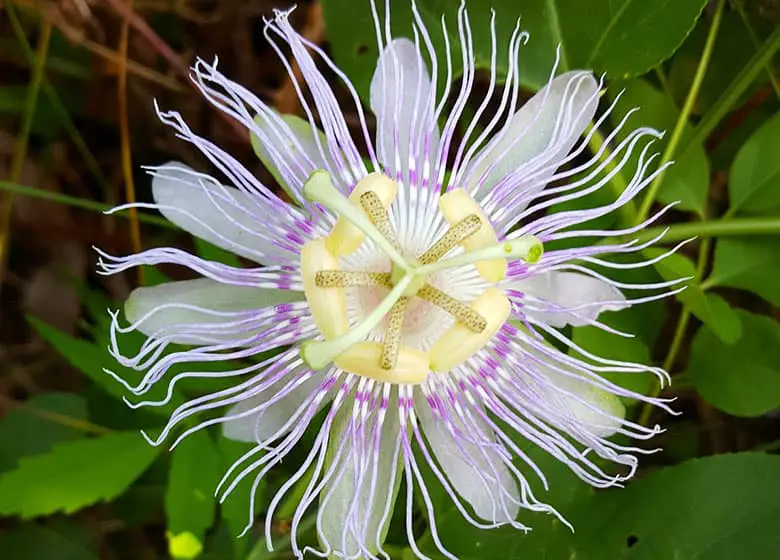
Gardeners throughout Florida can dress up a fence, arbor or trellis with this flowering vine that is also a native. Although there are several species of passion flowers native to Florida, Maypop (Passiflora incarnate) is the showiest, producing exotic 3- to 5-inch blooms that are purple or lavender and with wavy fringes over the petals. Flowers last for a day and green oval fruits form after the blooms fade that are edible, but said to not taste too good. The blooms attract a host of pollinators from bees, butterflies, moths, hummingbirds, bats and other insects. It’s also a host plant for zebra heliconia, checkered fritillary and gulf fritillary butterflies. Grow passion flower in a sunny site in fertile well-drained soil.
Pawpaw
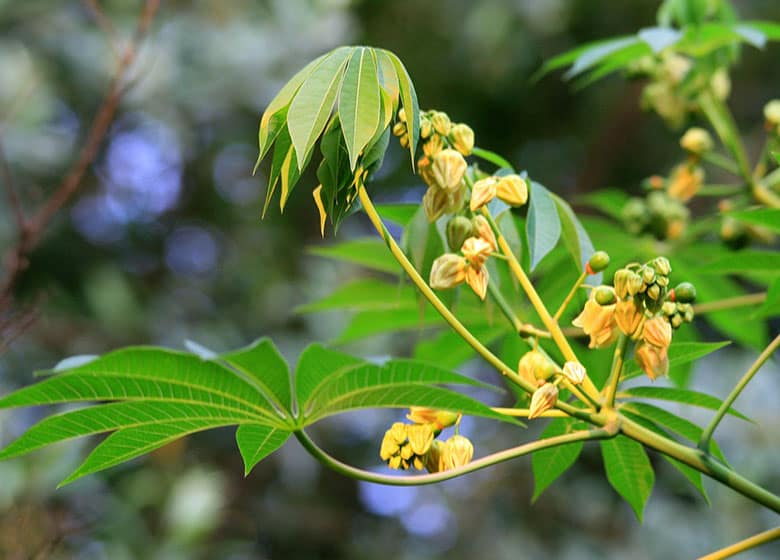
A United States native, pawpaw trees are hardy in northern sections of Florida, averaging around 15 feet tall. The deciduous tree produces large 6- to 12-inch long leaves and in springtime, just as the new leaves are uncurling, 2-inch purple blooms spring to life. After the flowers fade, 5-inch oval fruits form that are green and when ripe change to black and are said to taste like bananas. The zebra swallowtail butterfly uses pawpaw as a host plant and the fruits attract various wildlife. Grow in a site receiving full sun to shade and in well-drained soil.
Penta
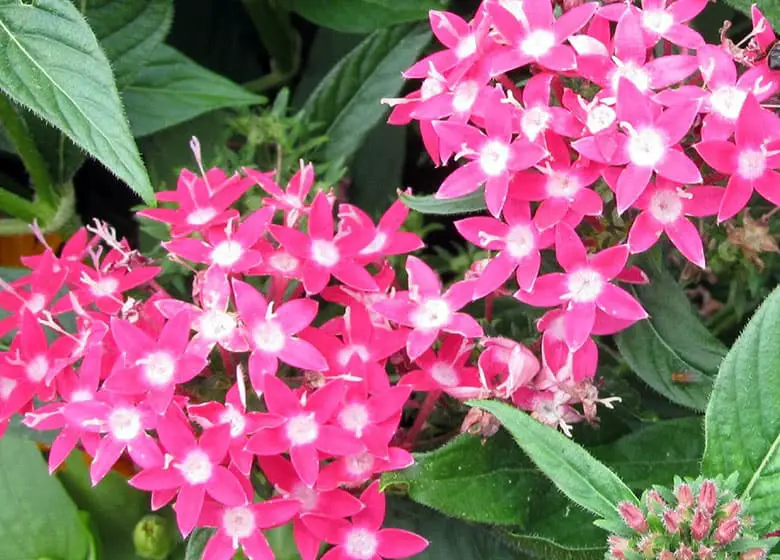
Commonly called star flower because of the profuse clusters of star-shaped flowers, penta is a must have in butterfly or hummingbird gardens. Dark green lance-shaped and slightly fuzzy foliage highlight the attractive flower clusters in colors of red, pinks, purple, white and two-toned. Warm temperatures promote an abundance of blooms. This evergreen perennial grows 3 feet tall and is hardy growing throughout Florida. Penta prefers a well-drained, fertile soil with regular water applications and in a sunny to shadier location, with sun promoting the most blooms.
Purple Coneflower
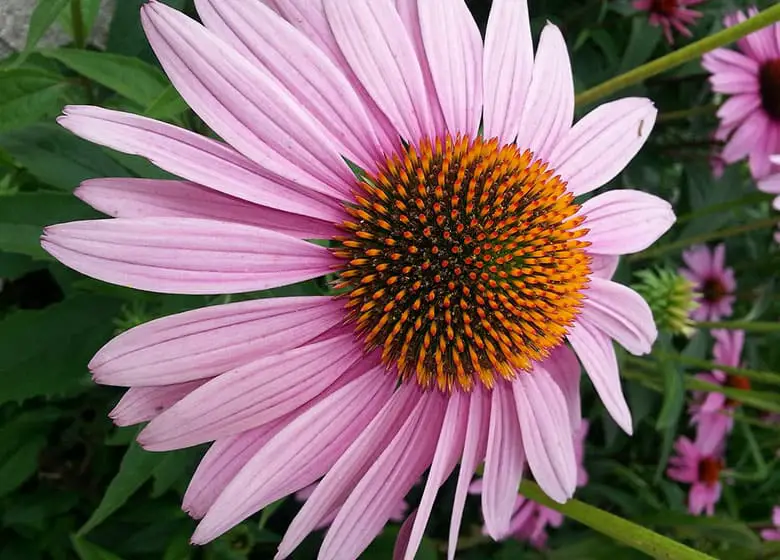
Purple coneflower is an herbaceous perennial throughout all but the most southern portions of the state, although many people treat it as an annual. During winter, it dies to the ground only to regrow in spring. Attractive clumps of lance-shaped leaves highlight the stalks of purple daisylike flowers with large brown centers that attract various butterflies. Blooming starts in summer and carries on throughout fall. Grow this drought-tolerant beauty in full sun to partial sun and in well-drained soil.
Saltbush
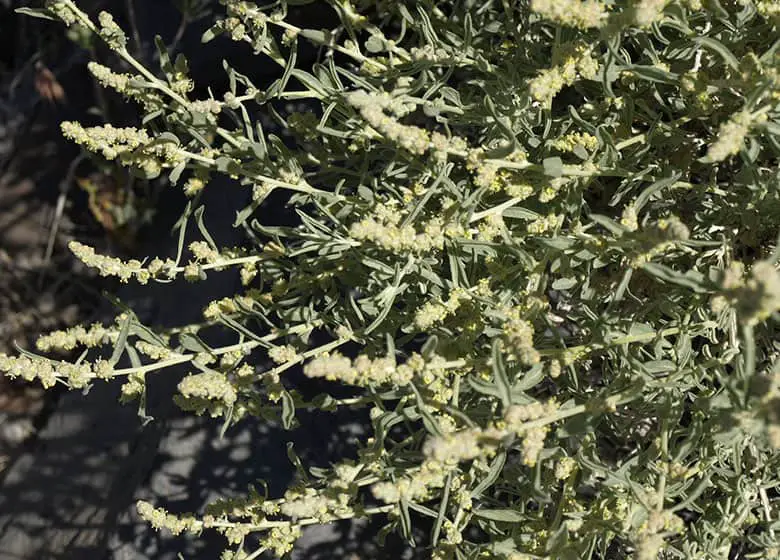
Saltbush is a native flowering shrub that is hardy throughout Florida and as its name suggests, it’s tolerant to salt spray as well as drought. Plants are dioecious, with both male and female plants flowering, although the females put on the showiest display covered in small white flowers starting in fall. Male blooms are more yellow and not as showy as the females. Various butterflies use the saltbush for nectar, including the monarch butterfly. It grows well in full sun to partial shade and in soils that are wet to dry.
Butterfly Gardening 101 – Tips & Plants
Don’t let lack of space stop you from creating a butterfly garden, because you can design your garden in as small of space as planting in containers and situating it on a patio. Those with larger areas in their Florida landscapes can almost fill their spaces with blooming perennials and shrubs that are sure to be a lure to butterflies, as well as other beneficial pollinators like bees and hummingbirds.
Additionally, successful butterfly gardens include these major components:
- Adult Nectar Sources: Provide an assortment of nectar producing plants that will attract a wide variety of butterflies.
- Larval Host Plants: Provides a source of food for the developing butterfly larvae and encourages butterflies to remain in your landscape and develop future populations. Interesting and educational to observe all the life stages.
- Shelter: Having vegetation incorporated into the landscape that offers locations for sleeping and roosting, as well as protection from predators, stormy and rainy weather and extremes in temperatures.
- Fountain Water Source: Offers butterflies easy access to a water source that is also consistent and thermoregulation.
When selecting plants for your butterfly garden, always consider the specific plant’s cultural preferences like preferred light, moisture and soil conditions compared to the chosen area in your landscape. Additionally, always grow multiple plants together that have similar needs to prevent potential growth problems.
What are the Most Common Butterflies in Florida?
Even though Florida is home to so many different types of butterflies, some species are more common than others are. These are the ones you will most likely see fluttering around your garden drinking nectar from your butterfly plants.
Some of the more common butterfly species include:
- Cloudless Sulphur Butterfly: A smaller butterfly, with adults a bright yellow, although females are sometime white and a lighter yellow.
- Zebra Swallowtail: Large butterfly with a wingspread of up to 4 inches. The top of the wings are white and striped in black, with the bottom wings sporting long tails.
- Red-Spotted Purple: Large butterfly with a wingspread of around 3.5 inches. The wings are an eye-catching blue-black color, with white and red spots lining the outer wings.
- Zebra Longwing: Florida’s state butterfly. The butterfly is medium-sized and sports distinctive black elongated wings striped in a bright yellow.
- Gulf Fritillary: A medium-sized butterfly that is bright orange with elongated wings containing black markings.
- Black Swallowtail: A medium to large butterfly with wingspreads around 8.4 cm. The upper wings are black with yellow spots and the lower wings have iridescent blue markings. The front portion of the wing’s underside contains two rows of light yellow spots and the lower wing section has bright orange spots and a section of powdery blue.
Can I use Pesticides on My Butterfly Plants?
Everyone has heard of dwindling bee populations due to the overuse of pesticides, especially synthetic types in the garden and on agriculture. Therefore, it goes to reason that to keep your landscape and the local ecosystem healthy, you should only use any type of pesticide when it’s absolutely necessary.
Additionally, just because a product states it’s organic doesn’t mean it isn’t toxic to butterflies and beneficial pollinators. Although most organic pesticides are made from plants, it doesn’t mean they are non-toxic to pollinator populations.
Butterflies do their activity during the daytime hours, so if you must spray your plants with something, it’s best done during the very early or evening hours so the product has time to dry.
Two of the safer pesticides you can use are insecticidal soap and horticultural oil. However, it’s still best to apply directly to the targeted pest and done early in the morning or in the evening when the butterflies aren’t present. It’s a good idea to test the product on a leaf to make sure there’s no damage before treating the entire plant.
Other more butterfly-friendly options in controlling pests include:
- Spraying the pests off with a blast of water.
- Hand picking the pests off the plants.
- Releasing other beneficial insects into the garden like ladybugs and green lacewings that attack and eat pests like aphids.
- Keeping your garden free of weeds that play host to pests like aphids.
No matter where you reside in Florida or your amount of butterfly garden space, you won’t be at a loss finding plants that attract the colorful beauties. Using Florida-friendly plants cuts down on your time tending fussy transplants, giving you more time to sit back and enjoy the alluring dance of the butterflies.
You will probably also like
